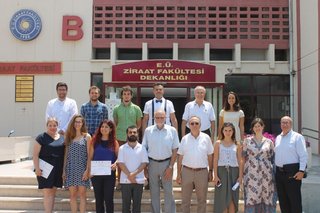The question about how surface cover (vegetation, crusts) affects the formation of small-scale topography through erosion and soil production processes is what my research activity is mainly focused on. As these processes shape the uppermost layers of the Earth’s continental crust, acquiring knowledge about soil properties and the soil-water relationship is of great importance to fulfil my research goals. The 5th Summer School “Soil and Water”, organized by the Department of Water Sciences of the Czech University of Life Sciences in Prague (CULS), was a perfect opportunity to deepen my knowledge in these fields of research. The Summer School was conducted at the Department of Soil Science and Plant Nutrition, which belongs to the Faculty of Agriculture of the Ege University in Izmir, Turkey.
Before the trip to Turkey took place, several preliminary e-lectures were given in order to ensure that all participants of the Summer School would have the same basic knowledge. In Izmir, daily teaching was divided into a lecture block in the morning and a laboratory/calculation block in the afternoon. This combination of theory and practical work had the great advantage that the subject matter could be understood more easily.
Main focus of the Summer School were hydrostatic and hydrodynamic processes within the soil as well as sampling techniques and laboratory methods to determine soil water content and Atterberg limits. Results were calculated on the computer.
Besides the lectures and laboratory work, three excursions were organized to different sites where main soil and water issues of the Aegean region could be studied. Several historical sites like Ephesus and Pergamon show impressive ancient freshwater and wastewater distribution networks. In the case of Ephesus, the impact of man-made erosion on sediment transport rates is impressively manifested by the coastal regression. In addition to that, the challenges of modern wastewater treatment were presented during a visit of the Çiğli wastewater treatment facility close to Izmir.
Besides the scientific aspect, the attendance to the Summer School allowed for the establishment of new social contacts. Participants and organizers came from the Czech Republic, Turkey, Austria, Spain, Brazil and Iran. Despite many cultural differences, the group turned out to be very homogeneous as the general passion of all participants is geoscience. A main benefit is definitely that I got insight into projects and studies dealing with several different geoscientific issues in Asia and Europe. Exchange of knowledge among the participants may opened the door for future cooperation and also acted as a mind-opener for my own study. The Summer School ended with a final written and oral exam, which underlines the scientific respectability of the event.
Overall, I can state that the visit of the Summer School was a first step to establish a network with other, non-German scientists. The exchange of knowledge with the participants will hopefully also continue in the future. While the lectures and methods used to study soil properties will be useful for my future research, the mixture of individual problem-solving strategies with respect to different cultural backgrounds was the most valuable experience I made during this Summer School.
Joel Mohren
PhD student
Institute of Geology and Mineralogy
PhD project: The effect of surface cover on Earth-shaping processes and the impact of climate and climate change on the formation of topography.
